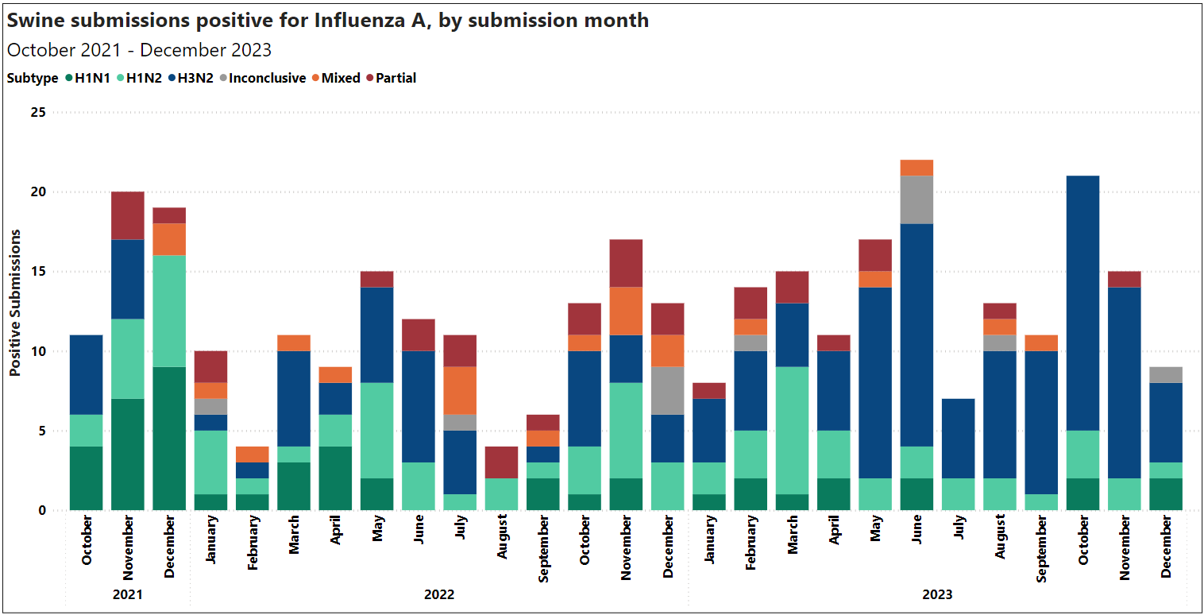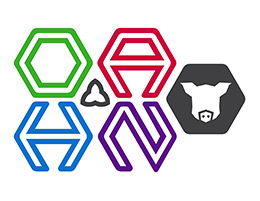Ontario Animal Health Network (OAHN) Swine Network Quarterly Veterinary Report
Novel Influenza A- H3N2 Cluster 2010.1 Update
On the 2023 Q vet survey, there were 93 % of practitioners ranking the frequency for IAV as common (43%) or very common (50%). There were 62% of practitioners that indicated that IAV activity was increased when compared to the previous quarter.
Dr. Hannah Golightly (OMAFRA) commented that the number of positive IAV submissions has been relatively stable over the last three Q4 periods. In Q4 2023, H3N2 detections were appreciably greater than any other subtype combined for each month of the quarter. This is a trend that has been ongoing since May 2023, and is markedly different than the last 2 years, where H3N2 detections only accounted for 20% and 28% of all positive cases in Q4 of 2021 and 2022, respectively. The majority of H3N2 detections in Q4 2023 were cluster 2010.1, most of which were detected in grow-finish herds.

Most positive submissions in Q4 2023 (October-December) involve subtype H3N2. Figure 1 also shows counts of partial, mixed and inconclusive subtypes isolated from Ontario swine herds.
(see legend above graph).
Porcine Epidemic Diarrhea (PEDV)/ Porcine Deltacoronavirus (PDCoV)
Jessica Fox, Manager at Swine Health Ontario (SHO) reported that the overall incidence of PED and PDCoV in Q4 was low. The following cases were reported in Q4 2023. The practitioner involved suggested that these cases were likely associated with lapses in biosecurity.
Dec. 27, 2023 Lambton PED Finisher
Dec. 29, 2023 Oxford PED Finisher
Jessica also reported that there were 8 additional cases in Q1 2024 thus far. Three cases where PED was detected initially infecting the sow herd and then the virus moved to two other related barns. With PDCoV there were also three cases that were detected in a farrowing unit and also infected two other barns in the downstream flow.
Jan. 03, 2024 Waterloo PED Nursery
Jan. 03, 2024 Waterloo PED Farrow-to-wean
Jan. 03, 2024 Perth PED Farrow-to-wean
Jan. 15, 2024 Oxford PED Farrow-to-finish
Jan. 18, 2024 Wellington PDCoV Finisher
Jan. 18, 2024 Haldimand PDCoV Farrow-to-wean
Jan. 22, 2024 Elgin PDCoV Nursery
Jan. 26, 2024 Middlesex PDCoV Nursery
All cases are pursuing elimination. Some of these cases were identified on a traceback from a positive test at a processing plant. This testing by processors continues to be extremely helpful. SHO has sent out a notice to the industry as reminder of the importance of following biosecurity protocols. The PED and PDCoV Tracking map is available on the Swine Health Ontario website and shows current and annual cases by county. http://www.swinehealthontario.ca/Disease-Information/PED-PDCoV-Tracking-Map
Porcine Circovirus Type II (PCV2) Cases Increase
On the OAHN swine Q4 veterinary survey, 62% of practitioners indicated that PCV2 activity was increased when compared to the previous quarter. This is a very notable increase from previous quarters and previous years. The cause for this perceived increase is unknown.
In the past veterinarians have commented that sporadic cases of clinical PCV2 has been related to vaccine storage or administration errors, fractionated dosages or changes in vaccine timing. Sow herd instability with increased shedding by sows and the subsequent increased infectious pressure can also set off increased clinical disease. Another possibility is that increasing PRRS challenges are undermining some of the PCV2 control. In the past most of these issues have been resolved. Since 2006 when PCV2 vaccines became available the control of PCV2 has been nothing less than remarkable even as the virus has slowly been evolving. Many in the industry are wondering if “the other shoe will drop” and we lose some of the control provided by the current vaccines. Too early to tell on this but we will certainly keep an eye on this one.
International Disease Topics Of Interest Summary
African Swine Fever (ASF): 2023 year in review
Six countries reported ASF for the first time in 2023: Bosnia and Herzegovina, Croatia, Kosovo, Sweden, Singapore, and Bangladesh. Five countries reported a resurgence of ASF after periods of no cases being reported or cases of ASF appeared in regions of the country that were previously unaffected: Lithuania, Greece, Italy, Mongolia, and the Philippines. (SHIC Swine Disease Global Surveillance Report, 12/05/23-01/01/24)
Belgium: China announced the lifting of its ban on pig and pork imports from Belgium. The ban was put in place when ASF was detected in Belgium in September of 2018. In November of 2020, Belgium was declared to be free of ASF. The country had gone over 12 months without detecting a case of ASF in wild boars. Belgium never had a case of ASF in domestic pigs. The Belgium Prime Minister met with the Chinese President and that same day China announced a ban on the importation of pigs, pork and wild boar products from Bangladesh due to ASF. (The Pig Site,1/19/24).
Take Home Message: Countries that have detected ASF, even those that have only detected the virus in wild pigs, have suffered bans on pork exports that last years. Swine producers should not expect anything different if ASF is detected in Canada.
Italy: Mislabeled vegan snacks from China were found to contain pork that tested positive for ASF. (CEZD,01/15/24). Yikes!
Take Home Messages: This article emphasizes how easily African Swine Fever or Classical Swine Fever could be brought into Canada through unknown pork products. All swine facilities should investigate into what foods farm workers may be bringing with them on-site and in lunches. Biosecurity on and off your farm is the most important line of defense. Review biosecurity protocols, including ensuring no pork products are allowed in the barn, with your family members and with staff.
How can you Participate in OAHN?
Share the information contained within this report with others involved in the swine industry and with other swine producers. Help us spread the word!
Ask your veterinarian for more information about topics included in this report.


